Human Resource Management Report: Australian Economy Issues
VerifiedAdded on 2020/05/16
|15
|3566
|71
Report
AI Summary
This report examines key issues in human resource management within the Australian economy, focusing on the gender imbalance in employee remuneration. It analyzes problems related to employee relations, motivation, rewards, and employee turnover, drawing on a case study and secondary literature. The report highlights disparities in pay, workforce gender balance, and subtle language biases in advertisements. It explores different approaches to industry relations, including Marxist, pluralist, and unitary perspectives, and emphasizes the importance of recruitment and selection processes in addressing these issues. The report concludes with recommendations for human resource managers to address the identified challenges, such as promoting equal pay, ensuring unbiased recruitment, and fostering a more equitable and motivated workforce.
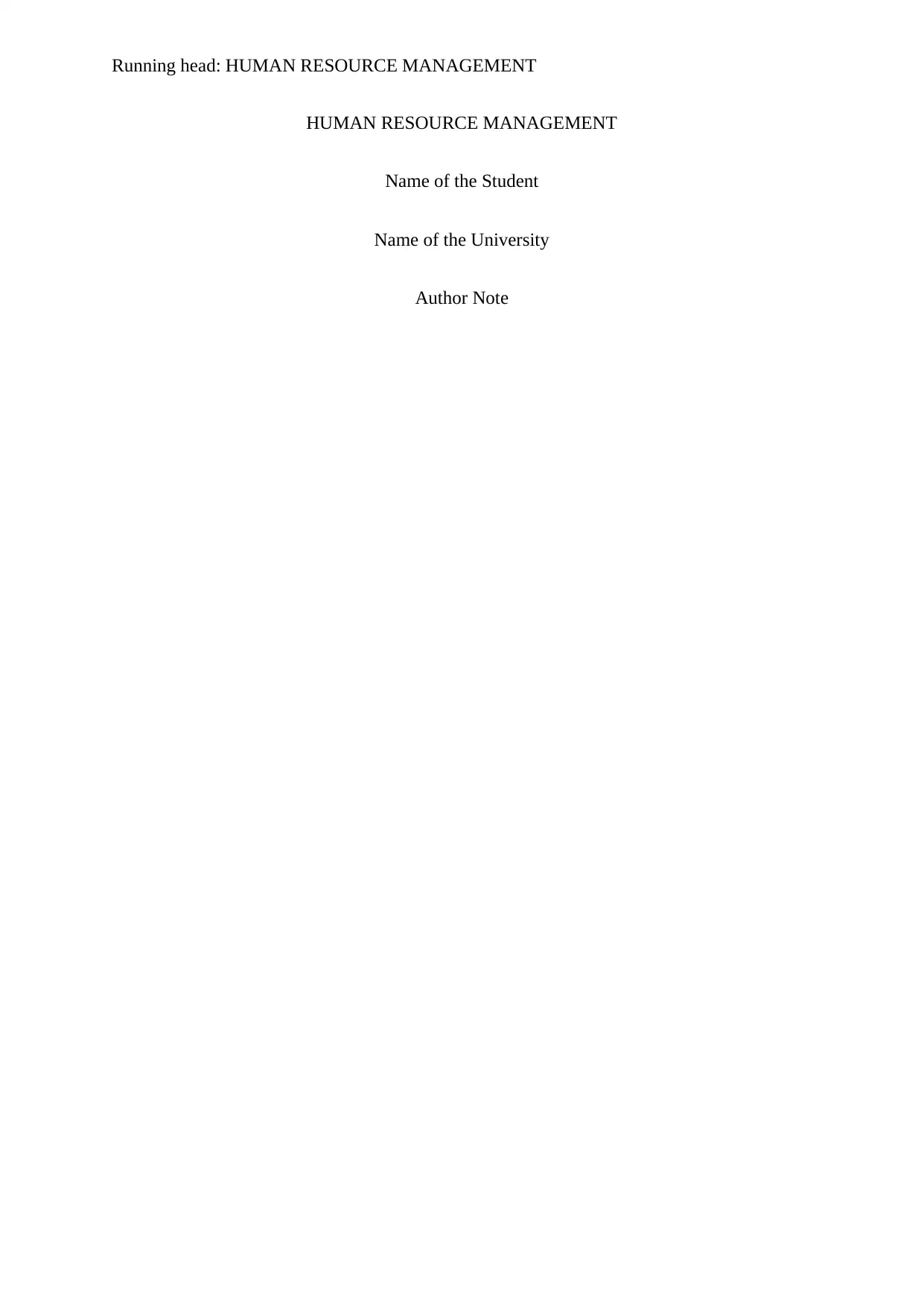
Running head: HUMAN RESOURCE MANAGEMENT
HUMAN RESOURCE MANAGEMENT
Name of the Student
Name of the University
Author Note
HUMAN RESOURCE MANAGEMENT
Name of the Student
Name of the University
Author Note
Paraphrase This Document
Need a fresh take? Get an instant paraphrase of this document with our AI Paraphraser
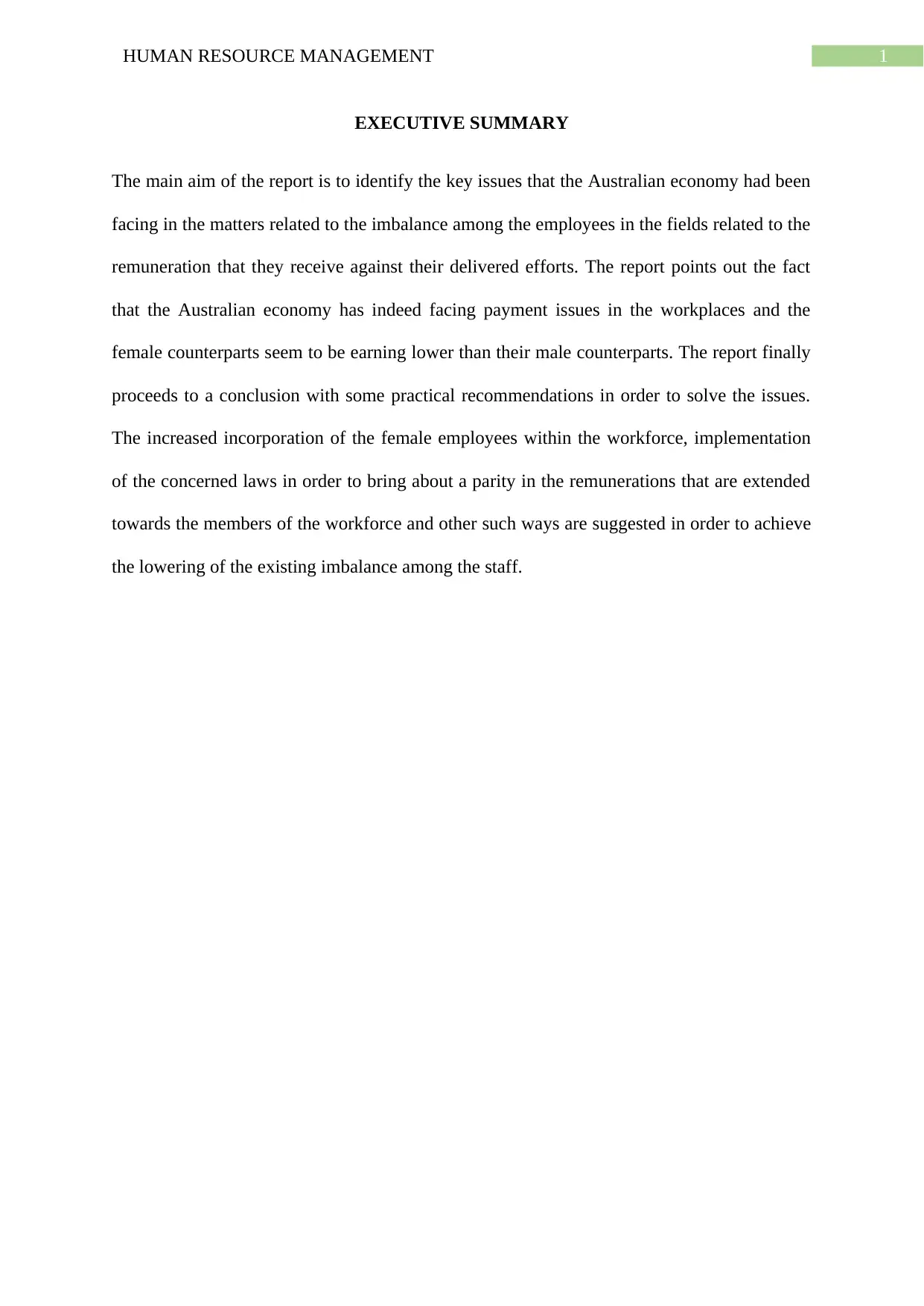
1HUMAN RESOURCE MANAGEMENT
EXECUTIVE SUMMARY
The main aim of the report is to identify the key issues that the Australian economy had been
facing in the matters related to the imbalance among the employees in the fields related to the
remuneration that they receive against their delivered efforts. The report points out the fact
that the Australian economy has indeed facing payment issues in the workplaces and the
female counterparts seem to be earning lower than their male counterparts. The report finally
proceeds to a conclusion with some practical recommendations in order to solve the issues.
The increased incorporation of the female employees within the workforce, implementation
of the concerned laws in order to bring about a parity in the remunerations that are extended
towards the members of the workforce and other such ways are suggested in order to achieve
the lowering of the existing imbalance among the staff.
EXECUTIVE SUMMARY
The main aim of the report is to identify the key issues that the Australian economy had been
facing in the matters related to the imbalance among the employees in the fields related to the
remuneration that they receive against their delivered efforts. The report points out the fact
that the Australian economy has indeed facing payment issues in the workplaces and the
female counterparts seem to be earning lower than their male counterparts. The report finally
proceeds to a conclusion with some practical recommendations in order to solve the issues.
The increased incorporation of the female employees within the workforce, implementation
of the concerned laws in order to bring about a parity in the remunerations that are extended
towards the members of the workforce and other such ways are suggested in order to achieve
the lowering of the existing imbalance among the staff.
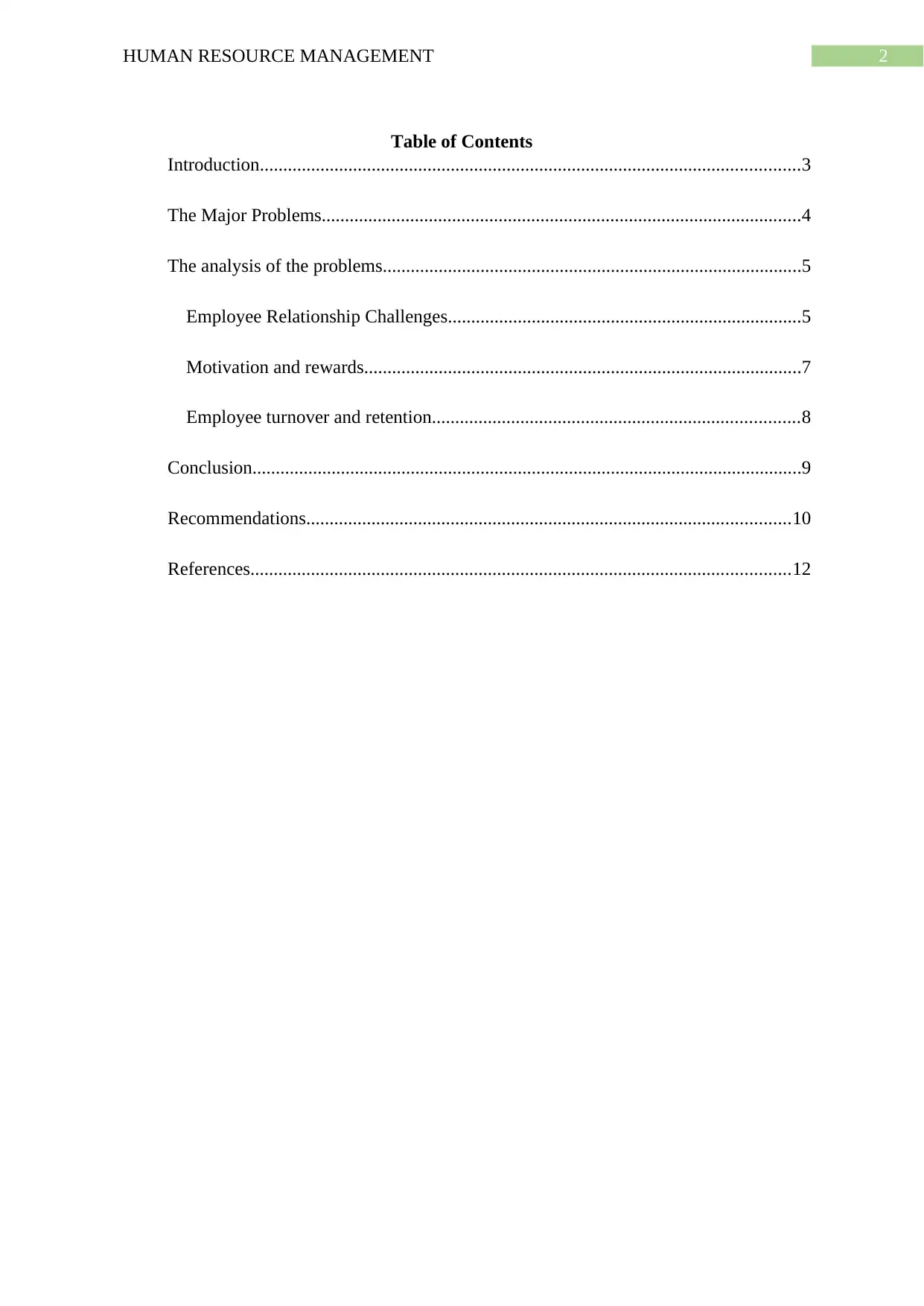
2HUMAN RESOURCE MANAGEMENT
Table of Contents
Introduction....................................................................................................................3
The Major Problems.......................................................................................................4
The analysis of the problems..........................................................................................5
Employee Relationship Challenges............................................................................5
Motivation and rewards..............................................................................................7
Employee turnover and retention...............................................................................8
Conclusion......................................................................................................................9
Recommendations........................................................................................................10
References....................................................................................................................12
Table of Contents
Introduction....................................................................................................................3
The Major Problems.......................................................................................................4
The analysis of the problems..........................................................................................5
Employee Relationship Challenges............................................................................5
Motivation and rewards..............................................................................................7
Employee turnover and retention...............................................................................8
Conclusion......................................................................................................................9
Recommendations........................................................................................................10
References....................................................................................................................12
⊘ This is a preview!⊘
Do you want full access?
Subscribe today to unlock all pages.

Trusted by 1+ million students worldwide
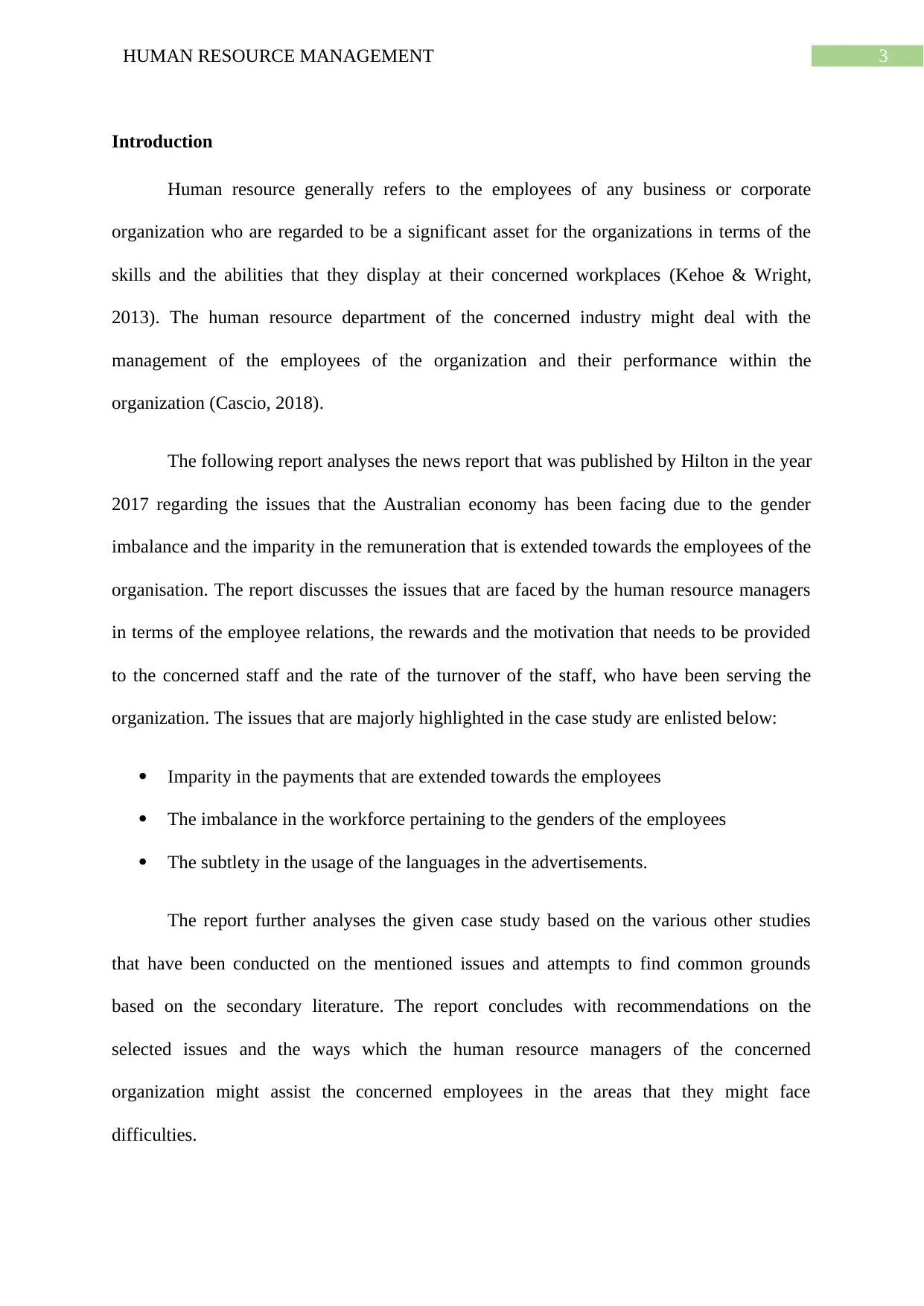
3HUMAN RESOURCE MANAGEMENT
Introduction
Human resource generally refers to the employees of any business or corporate
organization who are regarded to be a significant asset for the organizations in terms of the
skills and the abilities that they display at their concerned workplaces (Kehoe & Wright,
2013). The human resource department of the concerned industry might deal with the
management of the employees of the organization and their performance within the
organization (Cascio, 2018).
The following report analyses the news report that was published by Hilton in the year
2017 regarding the issues that the Australian economy has been facing due to the gender
imbalance and the imparity in the remuneration that is extended towards the employees of the
organisation. The report discusses the issues that are faced by the human resource managers
in terms of the employee relations, the rewards and the motivation that needs to be provided
to the concerned staff and the rate of the turnover of the staff, who have been serving the
organization. The issues that are majorly highlighted in the case study are enlisted below:
Imparity in the payments that are extended towards the employees
The imbalance in the workforce pertaining to the genders of the employees
The subtlety in the usage of the languages in the advertisements.
The report further analyses the given case study based on the various other studies
that have been conducted on the mentioned issues and attempts to find common grounds
based on the secondary literature. The report concludes with recommendations on the
selected issues and the ways which the human resource managers of the concerned
organization might assist the concerned employees in the areas that they might face
difficulties.
Introduction
Human resource generally refers to the employees of any business or corporate
organization who are regarded to be a significant asset for the organizations in terms of the
skills and the abilities that they display at their concerned workplaces (Kehoe & Wright,
2013). The human resource department of the concerned industry might deal with the
management of the employees of the organization and their performance within the
organization (Cascio, 2018).
The following report analyses the news report that was published by Hilton in the year
2017 regarding the issues that the Australian economy has been facing due to the gender
imbalance and the imparity in the remuneration that is extended towards the employees of the
organisation. The report discusses the issues that are faced by the human resource managers
in terms of the employee relations, the rewards and the motivation that needs to be provided
to the concerned staff and the rate of the turnover of the staff, who have been serving the
organization. The issues that are majorly highlighted in the case study are enlisted below:
Imparity in the payments that are extended towards the employees
The imbalance in the workforce pertaining to the genders of the employees
The subtlety in the usage of the languages in the advertisements.
The report further analyses the given case study based on the various other studies
that have been conducted on the mentioned issues and attempts to find common grounds
based on the secondary literature. The report concludes with recommendations on the
selected issues and the ways which the human resource managers of the concerned
organization might assist the concerned employees in the areas that they might face
difficulties.
Paraphrase This Document
Need a fresh take? Get an instant paraphrase of this document with our AI Paraphraser
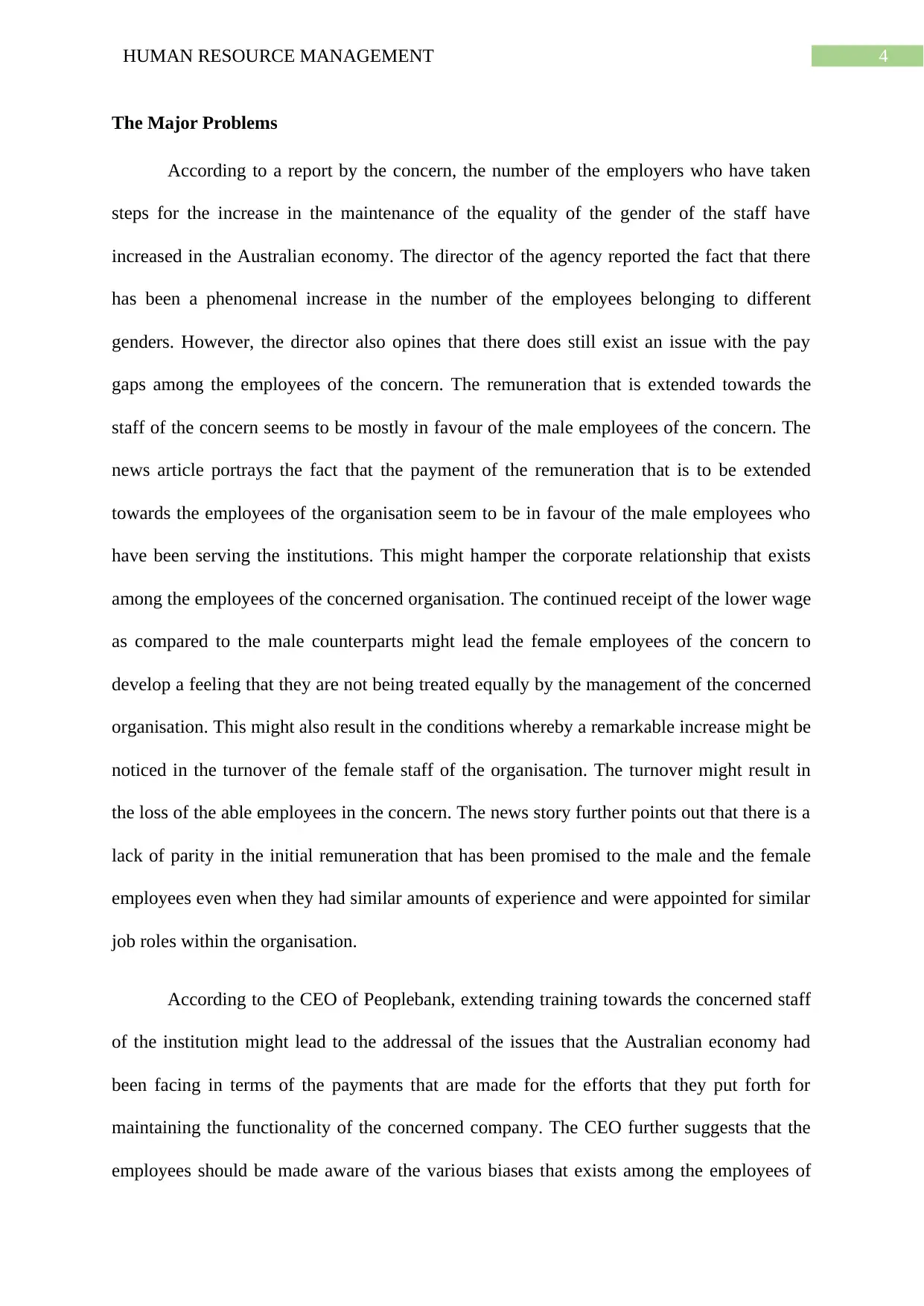
4HUMAN RESOURCE MANAGEMENT
The Major Problems
According to a report by the concern, the number of the employers who have taken
steps for the increase in the maintenance of the equality of the gender of the staff have
increased in the Australian economy. The director of the agency reported the fact that there
has been a phenomenal increase in the number of the employees belonging to different
genders. However, the director also opines that there does still exist an issue with the pay
gaps among the employees of the concern. The remuneration that is extended towards the
staff of the concern seems to be mostly in favour of the male employees of the concern. The
news article portrays the fact that the payment of the remuneration that is to be extended
towards the employees of the organisation seem to be in favour of the male employees who
have been serving the institutions. This might hamper the corporate relationship that exists
among the employees of the concerned organisation. The continued receipt of the lower wage
as compared to the male counterparts might lead the female employees of the concern to
develop a feeling that they are not being treated equally by the management of the concerned
organisation. This might also result in the conditions whereby a remarkable increase might be
noticed in the turnover of the female staff of the organisation. The turnover might result in
the loss of the able employees in the concern. The news story further points out that there is a
lack of parity in the initial remuneration that has been promised to the male and the female
employees even when they had similar amounts of experience and were appointed for similar
job roles within the organisation.
According to the CEO of Peoplebank, extending training towards the concerned staff
of the institution might lead to the addressal of the issues that the Australian economy had
been facing in terms of the payments that are made for the efforts that they put forth for
maintaining the functionality of the concerned company. The CEO further suggests that the
employees should be made aware of the various biases that exists among the employees of
The Major Problems
According to a report by the concern, the number of the employers who have taken
steps for the increase in the maintenance of the equality of the gender of the staff have
increased in the Australian economy. The director of the agency reported the fact that there
has been a phenomenal increase in the number of the employees belonging to different
genders. However, the director also opines that there does still exist an issue with the pay
gaps among the employees of the concern. The remuneration that is extended towards the
staff of the concern seems to be mostly in favour of the male employees of the concern. The
news article portrays the fact that the payment of the remuneration that is to be extended
towards the employees of the organisation seem to be in favour of the male employees who
have been serving the institutions. This might hamper the corporate relationship that exists
among the employees of the concerned organisation. The continued receipt of the lower wage
as compared to the male counterparts might lead the female employees of the concern to
develop a feeling that they are not being treated equally by the management of the concerned
organisation. This might also result in the conditions whereby a remarkable increase might be
noticed in the turnover of the female staff of the organisation. The turnover might result in
the loss of the able employees in the concern. The news story further points out that there is a
lack of parity in the initial remuneration that has been promised to the male and the female
employees even when they had similar amounts of experience and were appointed for similar
job roles within the organisation.
According to the CEO of Peoplebank, extending training towards the concerned staff
of the institution might lead to the addressal of the issues that the Australian economy had
been facing in terms of the payments that are made for the efforts that they put forth for
maintaining the functionality of the concerned company. The CEO further suggests that the
employees should be made aware of the various biases that exists among the employees of
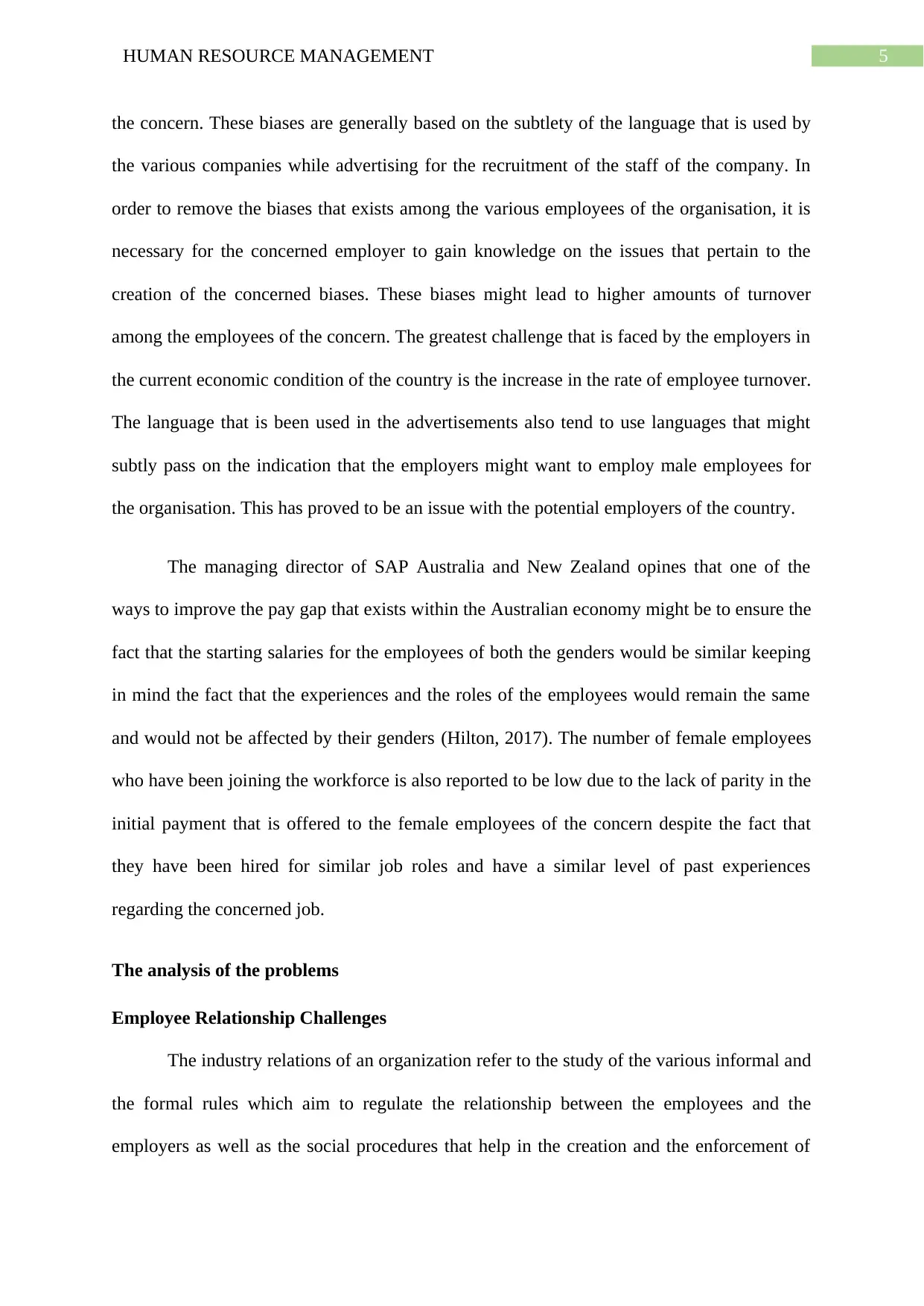
5HUMAN RESOURCE MANAGEMENT
the concern. These biases are generally based on the subtlety of the language that is used by
the various companies while advertising for the recruitment of the staff of the company. In
order to remove the biases that exists among the various employees of the organisation, it is
necessary for the concerned employer to gain knowledge on the issues that pertain to the
creation of the concerned biases. These biases might lead to higher amounts of turnover
among the employees of the concern. The greatest challenge that is faced by the employers in
the current economic condition of the country is the increase in the rate of employee turnover.
The language that is been used in the advertisements also tend to use languages that might
subtly pass on the indication that the employers might want to employ male employees for
the organisation. This has proved to be an issue with the potential employers of the country.
The managing director of SAP Australia and New Zealand opines that one of the
ways to improve the pay gap that exists within the Australian economy might be to ensure the
fact that the starting salaries for the employees of both the genders would be similar keeping
in mind the fact that the experiences and the roles of the employees would remain the same
and would not be affected by their genders (Hilton, 2017). The number of female employees
who have been joining the workforce is also reported to be low due to the lack of parity in the
initial payment that is offered to the female employees of the concern despite the fact that
they have been hired for similar job roles and have a similar level of past experiences
regarding the concerned job.
The analysis of the problems
Employee Relationship Challenges
The industry relations of an organization refer to the study of the various informal and
the formal rules which aim to regulate the relationship between the employees and the
employers as well as the social procedures that help in the creation and the enforcement of
the concern. These biases are generally based on the subtlety of the language that is used by
the various companies while advertising for the recruitment of the staff of the company. In
order to remove the biases that exists among the various employees of the organisation, it is
necessary for the concerned employer to gain knowledge on the issues that pertain to the
creation of the concerned biases. These biases might lead to higher amounts of turnover
among the employees of the concern. The greatest challenge that is faced by the employers in
the current economic condition of the country is the increase in the rate of employee turnover.
The language that is been used in the advertisements also tend to use languages that might
subtly pass on the indication that the employers might want to employ male employees for
the organisation. This has proved to be an issue with the potential employers of the country.
The managing director of SAP Australia and New Zealand opines that one of the
ways to improve the pay gap that exists within the Australian economy might be to ensure the
fact that the starting salaries for the employees of both the genders would be similar keeping
in mind the fact that the experiences and the roles of the employees would remain the same
and would not be affected by their genders (Hilton, 2017). The number of female employees
who have been joining the workforce is also reported to be low due to the lack of parity in the
initial payment that is offered to the female employees of the concern despite the fact that
they have been hired for similar job roles and have a similar level of past experiences
regarding the concerned job.
The analysis of the problems
Employee Relationship Challenges
The industry relations of an organization refer to the study of the various informal and
the formal rules which aim to regulate the relationship between the employees and the
employers as well as the social procedures that help in the creation and the enforcement of
⊘ This is a preview!⊘
Do you want full access?
Subscribe today to unlock all pages.

Trusted by 1+ million students worldwide
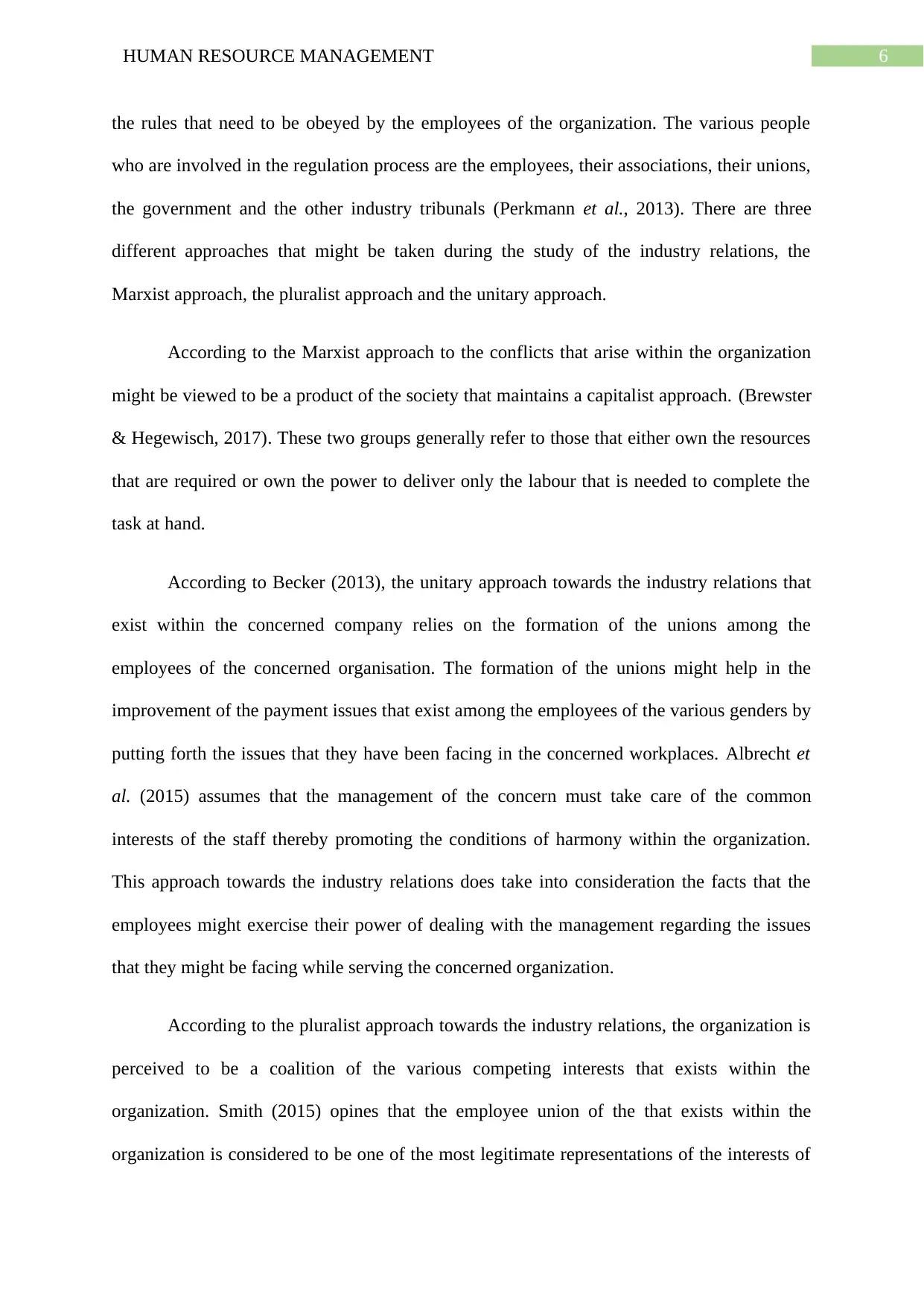
6HUMAN RESOURCE MANAGEMENT
the rules that need to be obeyed by the employees of the organization. The various people
who are involved in the regulation process are the employees, their associations, their unions,
the government and the other industry tribunals (Perkmann et al., 2013). There are three
different approaches that might be taken during the study of the industry relations, the
Marxist approach, the pluralist approach and the unitary approach.
According to the Marxist approach to the conflicts that arise within the organization
might be viewed to be a product of the society that maintains a capitalist approach. (Brewster
& Hegewisch, 2017). These two groups generally refer to those that either own the resources
that are required or own the power to deliver only the labour that is needed to complete the
task at hand.
According to Becker (2013), the unitary approach towards the industry relations that
exist within the concerned company relies on the formation of the unions among the
employees of the concerned organisation. The formation of the unions might help in the
improvement of the payment issues that exist among the employees of the various genders by
putting forth the issues that they have been facing in the concerned workplaces. Albrecht et
al. (2015) assumes that the management of the concern must take care of the common
interests of the staff thereby promoting the conditions of harmony within the organization.
This approach towards the industry relations does take into consideration the facts that the
employees might exercise their power of dealing with the management regarding the issues
that they might be facing while serving the concerned organization.
According to the pluralist approach towards the industry relations, the organization is
perceived to be a coalition of the various competing interests that exists within the
organization. Smith (2015) opines that the employee union of the that exists within the
organization is considered to be one of the most legitimate representations of the interests of
the rules that need to be obeyed by the employees of the organization. The various people
who are involved in the regulation process are the employees, their associations, their unions,
the government and the other industry tribunals (Perkmann et al., 2013). There are three
different approaches that might be taken during the study of the industry relations, the
Marxist approach, the pluralist approach and the unitary approach.
According to the Marxist approach to the conflicts that arise within the organization
might be viewed to be a product of the society that maintains a capitalist approach. (Brewster
& Hegewisch, 2017). These two groups generally refer to those that either own the resources
that are required or own the power to deliver only the labour that is needed to complete the
task at hand.
According to Becker (2013), the unitary approach towards the industry relations that
exist within the concerned company relies on the formation of the unions among the
employees of the concerned organisation. The formation of the unions might help in the
improvement of the payment issues that exist among the employees of the various genders by
putting forth the issues that they have been facing in the concerned workplaces. Albrecht et
al. (2015) assumes that the management of the concern must take care of the common
interests of the staff thereby promoting the conditions of harmony within the organization.
This approach towards the industry relations does take into consideration the facts that the
employees might exercise their power of dealing with the management regarding the issues
that they might be facing while serving the concerned organization.
According to the pluralist approach towards the industry relations, the organization is
perceived to be a coalition of the various competing interests that exists within the
organization. Smith (2015) opines that the employee union of the that exists within the
organization is considered to be one of the most legitimate representations of the interests of
Paraphrase This Document
Need a fresh take? Get an instant paraphrase of this document with our AI Paraphraser
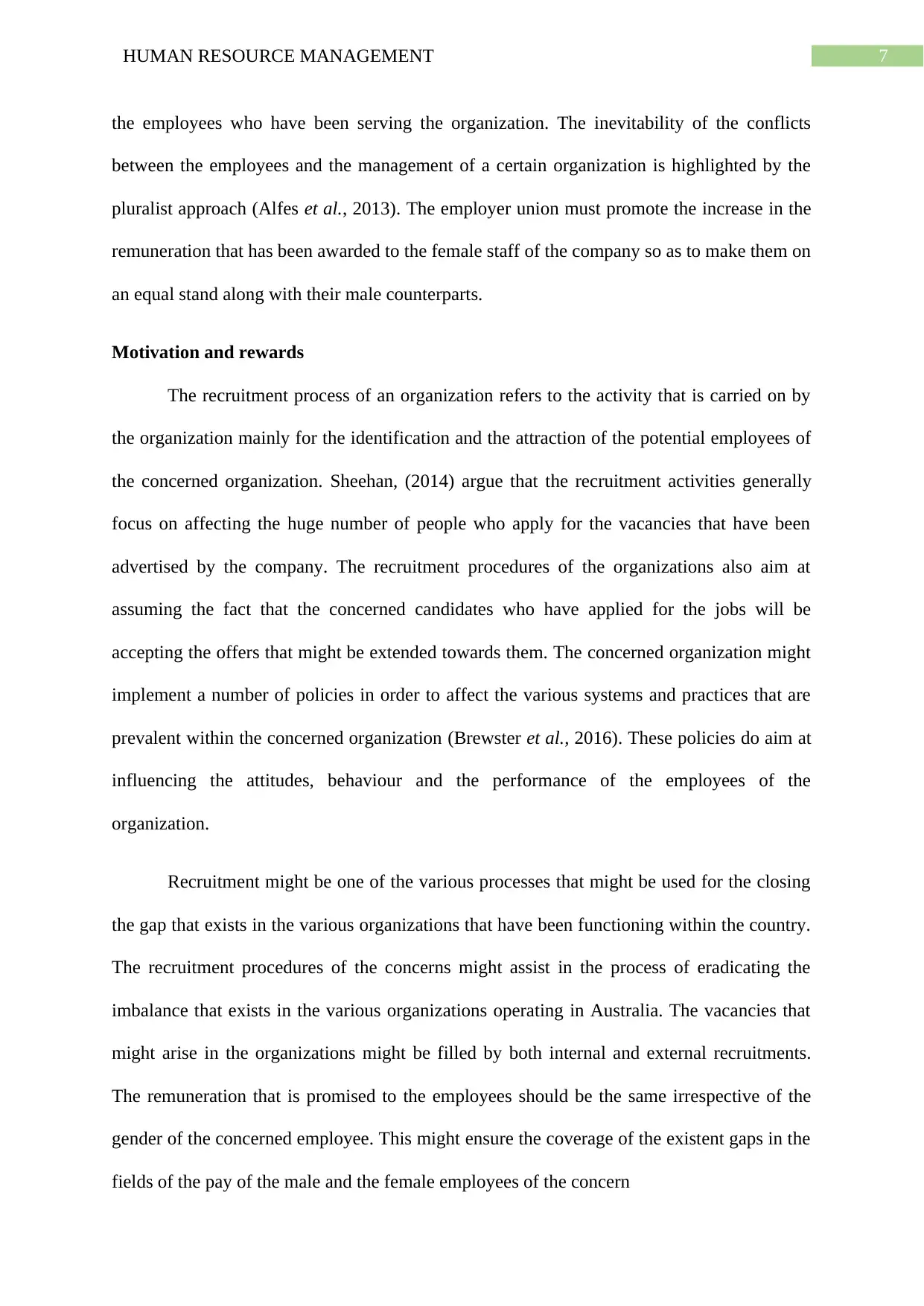
7HUMAN RESOURCE MANAGEMENT
the employees who have been serving the organization. The inevitability of the conflicts
between the employees and the management of a certain organization is highlighted by the
pluralist approach (Alfes et al., 2013). The employer union must promote the increase in the
remuneration that has been awarded to the female staff of the company so as to make them on
an equal stand along with their male counterparts.
Motivation and rewards
The recruitment process of an organization refers to the activity that is carried on by
the organization mainly for the identification and the attraction of the potential employees of
the concerned organization. Sheehan, (2014) argue that the recruitment activities generally
focus on affecting the huge number of people who apply for the vacancies that have been
advertised by the company. The recruitment procedures of the organizations also aim at
assuming the fact that the concerned candidates who have applied for the jobs will be
accepting the offers that might be extended towards them. The concerned organization might
implement a number of policies in order to affect the various systems and practices that are
prevalent within the concerned organization (Brewster et al., 2016). These policies do aim at
influencing the attitudes, behaviour and the performance of the employees of the
organization.
Recruitment might be one of the various processes that might be used for the closing
the gap that exists in the various organizations that have been functioning within the country.
The recruitment procedures of the concerns might assist in the process of eradicating the
imbalance that exists in the various organizations operating in Australia. The vacancies that
might arise in the organizations might be filled by both internal and external recruitments.
The remuneration that is promised to the employees should be the same irrespective of the
gender of the concerned employee. This might ensure the coverage of the existent gaps in the
fields of the pay of the male and the female employees of the concern
the employees who have been serving the organization. The inevitability of the conflicts
between the employees and the management of a certain organization is highlighted by the
pluralist approach (Alfes et al., 2013). The employer union must promote the increase in the
remuneration that has been awarded to the female staff of the company so as to make them on
an equal stand along with their male counterparts.
Motivation and rewards
The recruitment process of an organization refers to the activity that is carried on by
the organization mainly for the identification and the attraction of the potential employees of
the concerned organization. Sheehan, (2014) argue that the recruitment activities generally
focus on affecting the huge number of people who apply for the vacancies that have been
advertised by the company. The recruitment procedures of the organizations also aim at
assuming the fact that the concerned candidates who have applied for the jobs will be
accepting the offers that might be extended towards them. The concerned organization might
implement a number of policies in order to affect the various systems and practices that are
prevalent within the concerned organization (Brewster et al., 2016). These policies do aim at
influencing the attitudes, behaviour and the performance of the employees of the
organization.
Recruitment might be one of the various processes that might be used for the closing
the gap that exists in the various organizations that have been functioning within the country.
The recruitment procedures of the concerns might assist in the process of eradicating the
imbalance that exists in the various organizations operating in Australia. The vacancies that
might arise in the organizations might be filled by both internal and external recruitments.
The remuneration that is promised to the employees should be the same irrespective of the
gender of the concerned employee. This might ensure the coverage of the existent gaps in the
fields of the pay of the male and the female employees of the concern
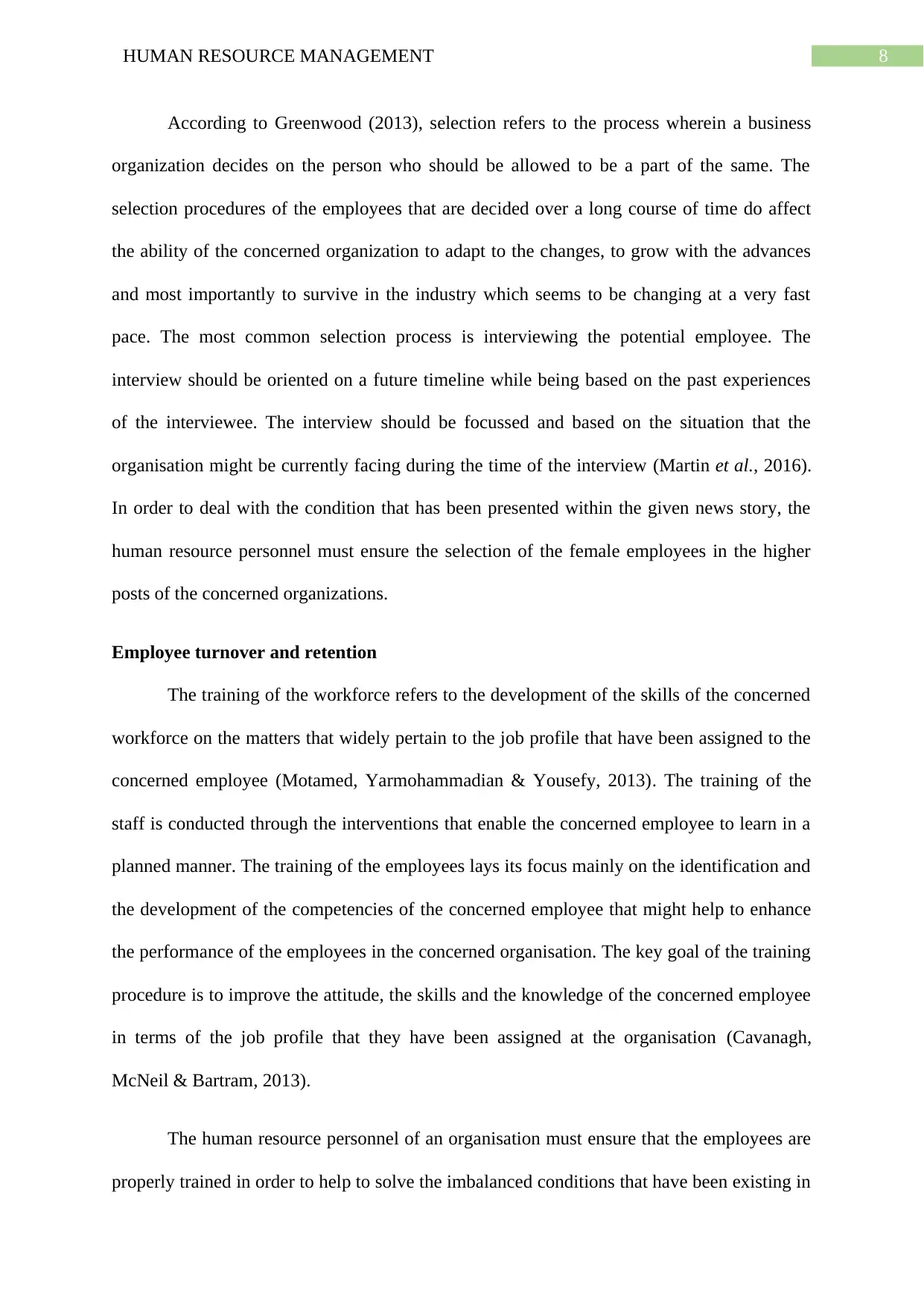
8HUMAN RESOURCE MANAGEMENT
According to Greenwood (2013), selection refers to the process wherein a business
organization decides on the person who should be allowed to be a part of the same. The
selection procedures of the employees that are decided over a long course of time do affect
the ability of the concerned organization to adapt to the changes, to grow with the advances
and most importantly to survive in the industry which seems to be changing at a very fast
pace. The most common selection process is interviewing the potential employee. The
interview should be oriented on a future timeline while being based on the past experiences
of the interviewee. The interview should be focussed and based on the situation that the
organisation might be currently facing during the time of the interview (Martin et al., 2016).
In order to deal with the condition that has been presented within the given news story, the
human resource personnel must ensure the selection of the female employees in the higher
posts of the concerned organizations.
Employee turnover and retention
The training of the workforce refers to the development of the skills of the concerned
workforce on the matters that widely pertain to the job profile that have been assigned to the
concerned employee (Motamed, Yarmohammadian & Yousefy, 2013). The training of the
staff is conducted through the interventions that enable the concerned employee to learn in a
planned manner. The training of the employees lays its focus mainly on the identification and
the development of the competencies of the concerned employee that might help to enhance
the performance of the employees in the concerned organisation. The key goal of the training
procedure is to improve the attitude, the skills and the knowledge of the concerned employee
in terms of the job profile that they have been assigned at the organisation (Cavanagh,
McNeil & Bartram, 2013).
The human resource personnel of an organisation must ensure that the employees are
properly trained in order to help to solve the imbalanced conditions that have been existing in
According to Greenwood (2013), selection refers to the process wherein a business
organization decides on the person who should be allowed to be a part of the same. The
selection procedures of the employees that are decided over a long course of time do affect
the ability of the concerned organization to adapt to the changes, to grow with the advances
and most importantly to survive in the industry which seems to be changing at a very fast
pace. The most common selection process is interviewing the potential employee. The
interview should be oriented on a future timeline while being based on the past experiences
of the interviewee. The interview should be focussed and based on the situation that the
organisation might be currently facing during the time of the interview (Martin et al., 2016).
In order to deal with the condition that has been presented within the given news story, the
human resource personnel must ensure the selection of the female employees in the higher
posts of the concerned organizations.
Employee turnover and retention
The training of the workforce refers to the development of the skills of the concerned
workforce on the matters that widely pertain to the job profile that have been assigned to the
concerned employee (Motamed, Yarmohammadian & Yousefy, 2013). The training of the
staff is conducted through the interventions that enable the concerned employee to learn in a
planned manner. The training of the employees lays its focus mainly on the identification and
the development of the competencies of the concerned employee that might help to enhance
the performance of the employees in the concerned organisation. The key goal of the training
procedure is to improve the attitude, the skills and the knowledge of the concerned employee
in terms of the job profile that they have been assigned at the organisation (Cavanagh,
McNeil & Bartram, 2013).
The human resource personnel of an organisation must ensure that the employees are
properly trained in order to help to solve the imbalanced conditions that have been existing in
⊘ This is a preview!⊘
Do you want full access?
Subscribe today to unlock all pages.

Trusted by 1+ million students worldwide
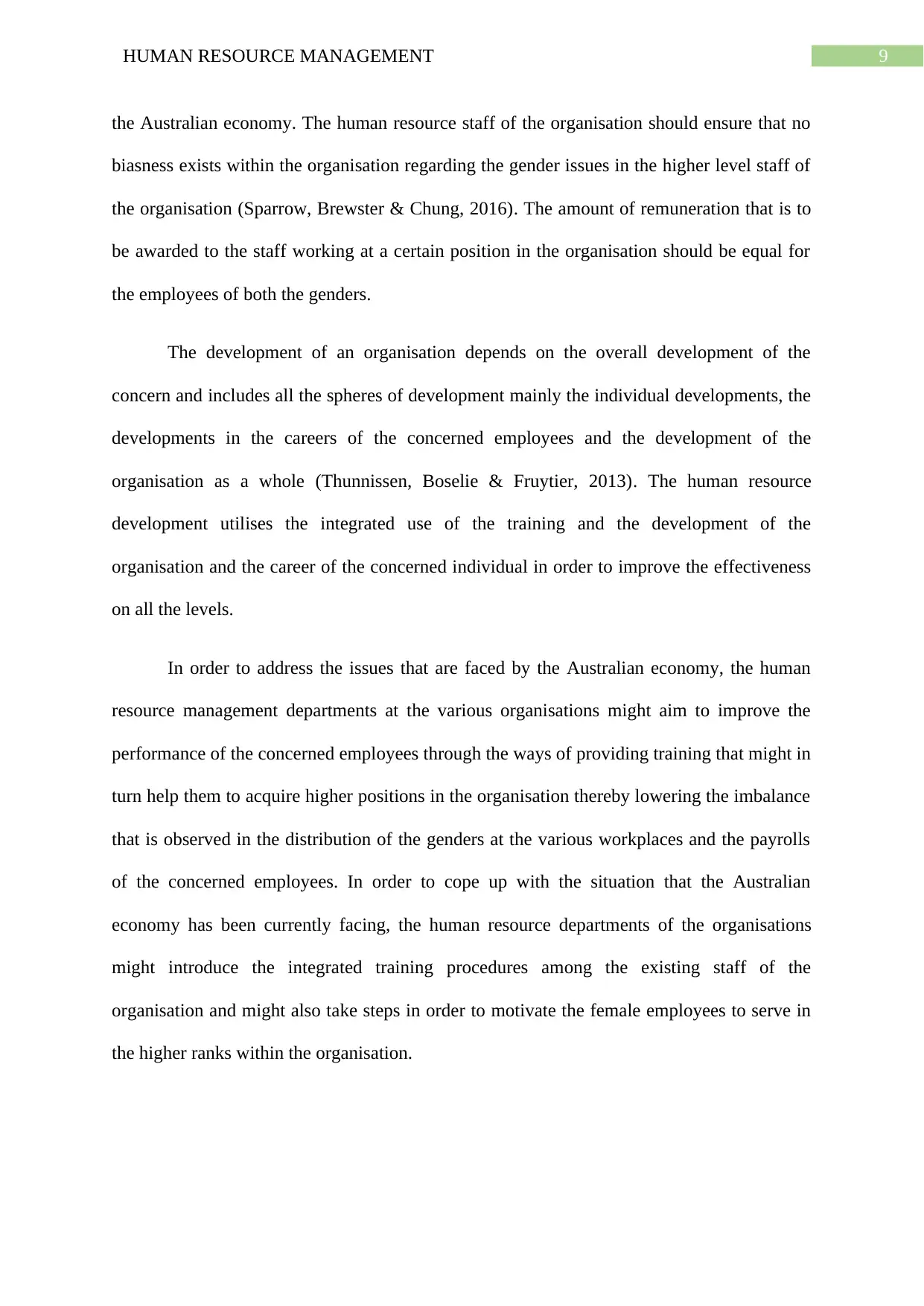
9HUMAN RESOURCE MANAGEMENT
the Australian economy. The human resource staff of the organisation should ensure that no
biasness exists within the organisation regarding the gender issues in the higher level staff of
the organisation (Sparrow, Brewster & Chung, 2016). The amount of remuneration that is to
be awarded to the staff working at a certain position in the organisation should be equal for
the employees of both the genders.
The development of an organisation depends on the overall development of the
concern and includes all the spheres of development mainly the individual developments, the
developments in the careers of the concerned employees and the development of the
organisation as a whole (Thunnissen, Boselie & Fruytier, 2013). The human resource
development utilises the integrated use of the training and the development of the
organisation and the career of the concerned individual in order to improve the effectiveness
on all the levels.
In order to address the issues that are faced by the Australian economy, the human
resource management departments at the various organisations might aim to improve the
performance of the concerned employees through the ways of providing training that might in
turn help them to acquire higher positions in the organisation thereby lowering the imbalance
that is observed in the distribution of the genders at the various workplaces and the payrolls
of the concerned employees. In order to cope up with the situation that the Australian
economy has been currently facing, the human resource departments of the organisations
might introduce the integrated training procedures among the existing staff of the
organisation and might also take steps in order to motivate the female employees to serve in
the higher ranks within the organisation.
the Australian economy. The human resource staff of the organisation should ensure that no
biasness exists within the organisation regarding the gender issues in the higher level staff of
the organisation (Sparrow, Brewster & Chung, 2016). The amount of remuneration that is to
be awarded to the staff working at a certain position in the organisation should be equal for
the employees of both the genders.
The development of an organisation depends on the overall development of the
concern and includes all the spheres of development mainly the individual developments, the
developments in the careers of the concerned employees and the development of the
organisation as a whole (Thunnissen, Boselie & Fruytier, 2013). The human resource
development utilises the integrated use of the training and the development of the
organisation and the career of the concerned individual in order to improve the effectiveness
on all the levels.
In order to address the issues that are faced by the Australian economy, the human
resource management departments at the various organisations might aim to improve the
performance of the concerned employees through the ways of providing training that might in
turn help them to acquire higher positions in the organisation thereby lowering the imbalance
that is observed in the distribution of the genders at the various workplaces and the payrolls
of the concerned employees. In order to cope up with the situation that the Australian
economy has been currently facing, the human resource departments of the organisations
might introduce the integrated training procedures among the existing staff of the
organisation and might also take steps in order to motivate the female employees to serve in
the higher ranks within the organisation.
Paraphrase This Document
Need a fresh take? Get an instant paraphrase of this document with our AI Paraphraser
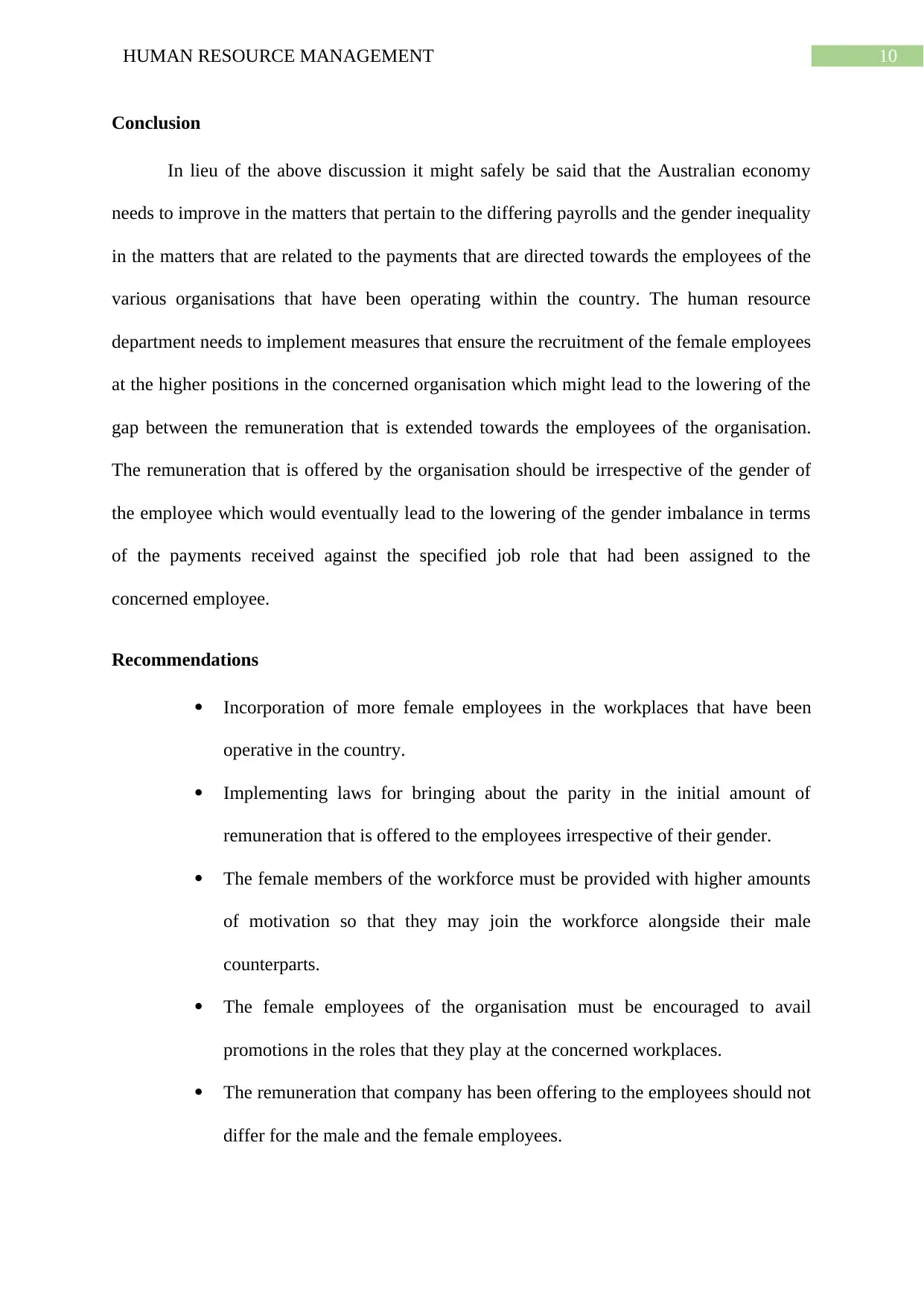
10HUMAN RESOURCE MANAGEMENT
Conclusion
In lieu of the above discussion it might safely be said that the Australian economy
needs to improve in the matters that pertain to the differing payrolls and the gender inequality
in the matters that are related to the payments that are directed towards the employees of the
various organisations that have been operating within the country. The human resource
department needs to implement measures that ensure the recruitment of the female employees
at the higher positions in the concerned organisation which might lead to the lowering of the
gap between the remuneration that is extended towards the employees of the organisation.
The remuneration that is offered by the organisation should be irrespective of the gender of
the employee which would eventually lead to the lowering of the gender imbalance in terms
of the payments received against the specified job role that had been assigned to the
concerned employee.
Recommendations
Incorporation of more female employees in the workplaces that have been
operative in the country.
Implementing laws for bringing about the parity in the initial amount of
remuneration that is offered to the employees irrespective of their gender.
The female members of the workforce must be provided with higher amounts
of motivation so that they may join the workforce alongside their male
counterparts.
The female employees of the organisation must be encouraged to avail
promotions in the roles that they play at the concerned workplaces.
The remuneration that company has been offering to the employees should not
differ for the male and the female employees.
Conclusion
In lieu of the above discussion it might safely be said that the Australian economy
needs to improve in the matters that pertain to the differing payrolls and the gender inequality
in the matters that are related to the payments that are directed towards the employees of the
various organisations that have been operating within the country. The human resource
department needs to implement measures that ensure the recruitment of the female employees
at the higher positions in the concerned organisation which might lead to the lowering of the
gap between the remuneration that is extended towards the employees of the organisation.
The remuneration that is offered by the organisation should be irrespective of the gender of
the employee which would eventually lead to the lowering of the gender imbalance in terms
of the payments received against the specified job role that had been assigned to the
concerned employee.
Recommendations
Incorporation of more female employees in the workplaces that have been
operative in the country.
Implementing laws for bringing about the parity in the initial amount of
remuneration that is offered to the employees irrespective of their gender.
The female members of the workforce must be provided with higher amounts
of motivation so that they may join the workforce alongside their male
counterparts.
The female employees of the organisation must be encouraged to avail
promotions in the roles that they play at the concerned workplaces.
The remuneration that company has been offering to the employees should not
differ for the male and the female employees.
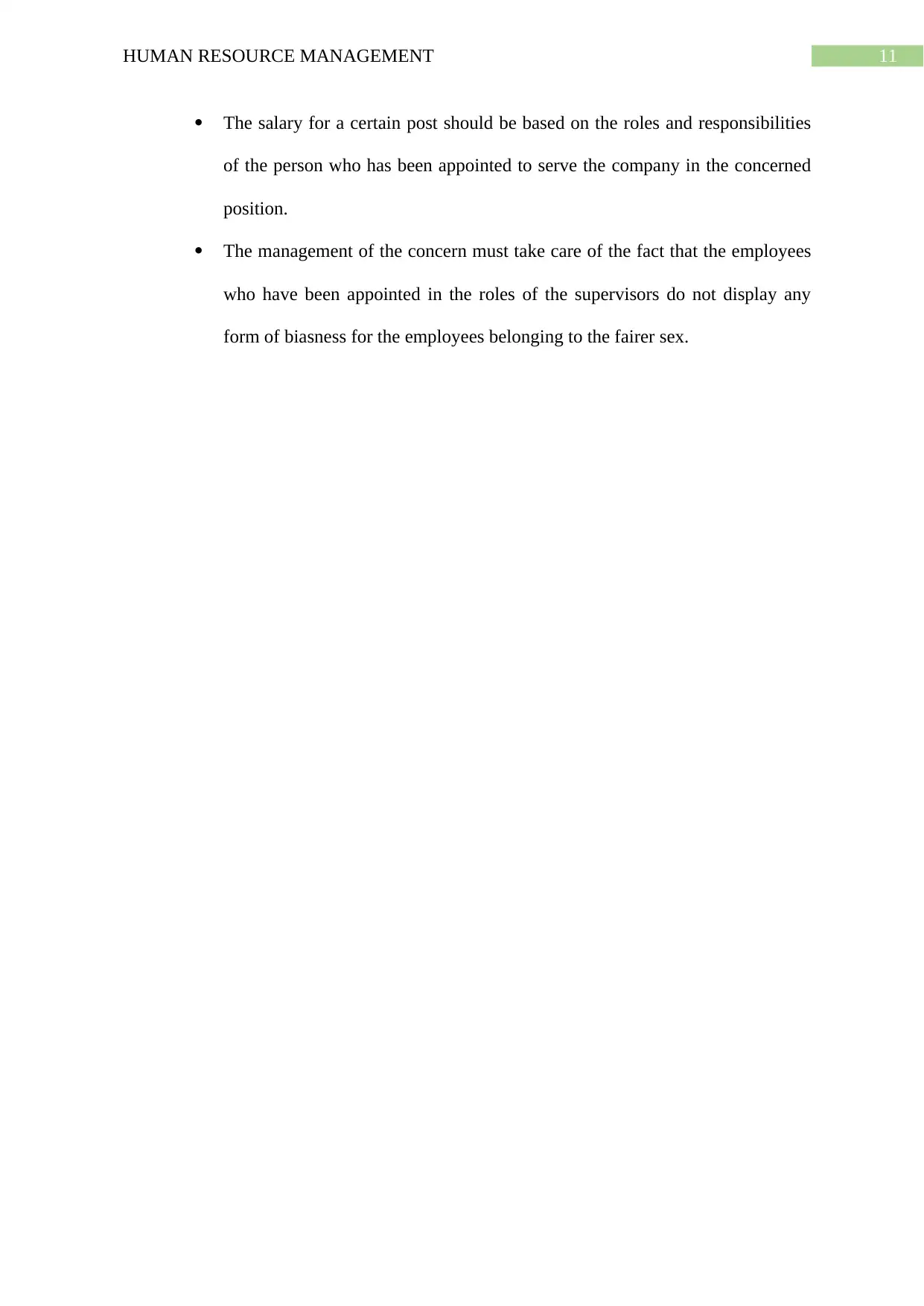
11HUMAN RESOURCE MANAGEMENT
The salary for a certain post should be based on the roles and responsibilities
of the person who has been appointed to serve the company in the concerned
position.
The management of the concern must take care of the fact that the employees
who have been appointed in the roles of the supervisors do not display any
form of biasness for the employees belonging to the fairer sex.
The salary for a certain post should be based on the roles and responsibilities
of the person who has been appointed to serve the company in the concerned
position.
The management of the concern must take care of the fact that the employees
who have been appointed in the roles of the supervisors do not display any
form of biasness for the employees belonging to the fairer sex.
⊘ This is a preview!⊘
Do you want full access?
Subscribe today to unlock all pages.

Trusted by 1+ million students worldwide
1 out of 15
Related Documents
Your All-in-One AI-Powered Toolkit for Academic Success.
+13062052269
info@desklib.com
Available 24*7 on WhatsApp / Email
![[object Object]](/_next/static/media/star-bottom.7253800d.svg)
Unlock your academic potential
Copyright © 2020–2025 A2Z Services. All Rights Reserved. Developed and managed by ZUCOL.





